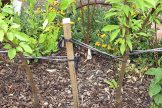
Potatoes have been a staple in our diet for hundreds of years. Growing them is easy, so why not start thinking about producing your own home grown potatoes. For those who love their spuds, you’ll love the variety of seed potatoes we have available at BAAG from May to late winter. They come packaged and depending on the year, we stock a large range of popular varieties as well as many unusual ones like King Edward, Banana or Royal Blue. Seed potatoes refer to the fact that they are disease-free. They still look like ordinary potatoes, not seeds! You can’t guarantee that the spuds that have started to sprout in your pantry aren’t carrying viruses, so planting those may lead to disappointment.
Position
Potatoes love a sunny, well drained position in your garden. Potatoes can be left to sprout before planting by leaving them in a light, cool, dry place. Chitting potatoes like this helps them crop earlier. You can plant them straight away too. As the potatoes are usually available from May, they are considered a winter crop. If you are in a frost prone area, purchase them when they are available in winter, but don’t plant them out until the frost has past. Alternatively, you can plant them in a pot or potato bag in winter, and move into the open once the frost as finished or, if planted in the ground, cover them with a light cloth or hessian bag overnight if frost is expected.

Preparation and Planting
Work in loads of well-rotted manures and composts before planting as potatoes are hungry plants. This will also help with water retention too. Blood & Bone and Potash are also favourites of potatoes.
Seed potatoes should be planted 10cm deep and approximately 30-35cm apart, with rows 60cm apart. Seed potatoes can be cut into several pieces before planting each one up individually – just make sure that each section has a sprouting eye on it. Allow the cut potato to dry out before planting (and maybe even start sprouting) by keeping it in a dark, warm place.
Watering and Hilling
Adequate water is needed for potatoes to form but do not add too much as to make the soil soggy. Do not use untreated grey water on potatoes as the water will be in direct contact with the newly forming tubers. As the potatoes grow, mound (hill) up the soil around them and mulch up to the stem so the baby potatoes aren’t exposed to the sunlight. Sun causes potatoes to become green and toxic.
Another method of growing potatoes is using a no-dig method in potato grow bags.
Usually a 1kg bag of seed potatoes is a perfect amount for 2 grow bags… and luckily our potato grow bags come in packs of 2.
Place a little soil or potting mix in the bottom of the bag. Place 4-5 potatoes on top with spaces between them. Place a thick layer of straw on top of them followed by a 3cm layer of compost and 3 cm layer of cow manure. Add a little blood and bone on top of everything. Water in well!
When the green shoots of the potatoes appear, repeat the layering method again. You will need to do this 4-5 times during their growing season remembering to water in well. As the straw breaks down it becomes the perfect growing medium. If grow bags aren’t your thing, you can use garbage bins or cylinders made from chicken wire and stakes. The same principles apply: just keep covering the potatoes as they grow with straw and manure.
Harvesting
Potatoes are ready to be dug up when the tops of the plants wither and become yellow. Potatoes should then be stored in a dark, well-ventilated spot. One seed potato on average produces approximately 10 potatoes.





